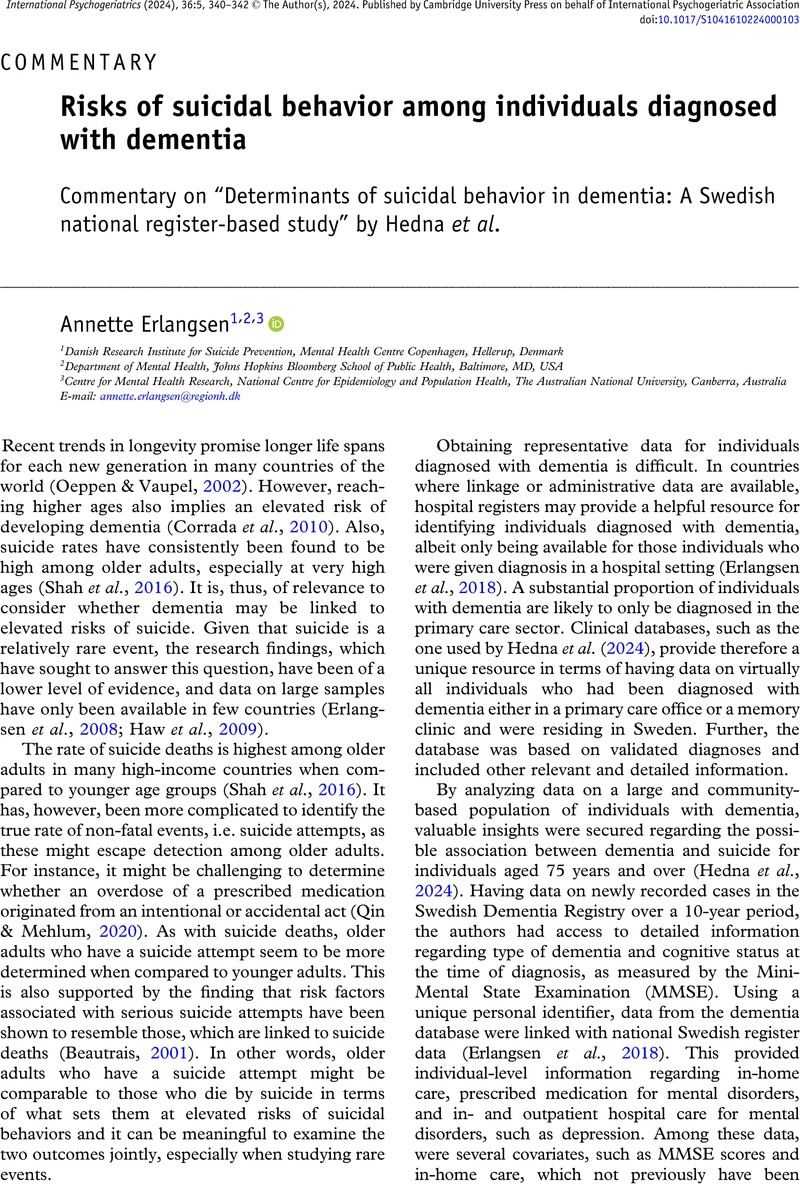No CrossRef data available.
Article contents
Risks of suicidal behavior among individuals diagnosed with dementia
Commentary on “Determinants of suicidal behavior in dementia: A Swedish national register-based study” by Hedna et al.
Published online by Cambridge University Press: 22 January 2024
Abstract
An abstract is not available for this content so a preview has been provided. Please use the Get access link above for information on how to access this content.

- Type
- Commentary
- Information
- International Psychogeriatrics , Volume 36 , Special Issue 5: Issue Theme: Suicide in Older Adults , May 2024 , pp. 340 - 342
- Copyright
- © The Author(s), 2024. Published by Cambridge University Press on behalf of International Psychogeriatric Association
References
Beautrais, A. (2001). Suicide and serious suicide attempts: two populations or one? Psychological Medicine, 31(5), 837–845.CrossRefGoogle ScholarPubMed
Conwell, Y., Duberstein, P. R., Hirsch, J. K., Conner, K. R., Eberly, S., & Caine, E. D. (2010). Health status and suicide in the second half of life. International Journal of Geriatric Psychiatry, 25(4), 371–379.CrossRefGoogle ScholarPubMed
Corrada, M. M., Brookmeyer, R., Paganini-Hill, A., Berlau, D., & Kawas, C. H. (2010). Dementia incidence continues to increase with age in the oldest old: the 90+ study. Annals of Neurology, 67(1), 114–121.CrossRefGoogle ScholarPubMed
Erlangsen, A., Qin, P., & Mittendorfer-Rutz, E. (2018). Studies of suicidal behavior using national registers. Crisis-the Journal of Crisis Intervention and Suicide Prevention, 39(3), 153–158.CrossRefGoogle ScholarPubMed
Erlangsen, A., Stenager, E., Conwell, Y., Andersen, P. K., Hawton, K., Benros, M. E., Nordentoft, M., & Stenager, E. (2020). Association between neurological disorders and death by suicide in Denmark. JAMA, 323(5), 444–454.CrossRefGoogle ScholarPubMed
Erlangsen, A., Zarit, S. H., & Conwell, Y. (2008). Hospital-diagnosed dementia and suicide: a longitudinal study using prospective, nationwide register data. The American Journal of Geriatric Psychiatry, 16(3), 220–228.CrossRefGoogle ScholarPubMed
Fässberg, M. M., Cheung, G., Canetto, S. S., Erlangsen, A., Lapierre, S., Lindner, R., Draper, B., Gallo, J. J., Wong, C., Wu, J., Duberstein, P., & Wærn, M. (2016). A systematic review of physical illness, functional disability, and suicidal behaviour among older adults. Aging and Mental Health, 20(2), 166–194.CrossRefGoogle ScholarPubMed
Gallo, J. J., Morales, K. H., Bogner, H. R., Raue, P. J., Zee, J., Bruce, M. L., & Reynolds, C. F. (2013). Long term effect of depression care management on mortality in older adults: follow-up of cluster randomized clinical trial in primary care. BMJ, 346(jun05 2), f2570–f2570.CrossRefGoogle ScholarPubMed
Haw, C., Harwood, D., & Hawton, K. (2009). Dementia and suicidal behavior: a review of the literature. International Psychogeriatrics, 21(03), 440–453.CrossRefGoogle ScholarPubMed
Hedna, K., Sigström, R., Johnell, K., & Waern, M. (2024). Determinants of suicidal behavior in dementia: A Swedish national register-based study. International Psychogeriatrics.Google Scholar
Kjolseth, I., Ekeberg, O., & Steihaug, S. (2010). Elderly people who committed suicide--their contact with the health service. What did they expect, and what did they get? Aging & Mental Health, 14(8), 938–946.CrossRefGoogle ScholarPubMed
Oeppen, J., & Vaupel, J. W. (2002). Broken limits to life expectancy. Science, 296(5570), 1029–1031.CrossRefGoogle ScholarPubMed
Petersen, B. D., Stenager, E., Mogensen, C. B., & Erlangsen, A. (2020). The association between heart diseases and suicide: a nationwide cohort study. Journal of Internal Medicine, 287(5), 558–568.CrossRefGoogle ScholarPubMed
Qin, P., & Mehlum, L. (2020). Deliberate self-harm: case identification and incidence estimate upon data from national patient registry. PloS One, 15(4), e0231885.CrossRefGoogle ScholarPubMed
Shah, A., Bhat, R., Zarate-Escudero, S., DeLeo, D., & Erlangsen, A. (2016). Suicide rates in five-year age-bands after the age of 60 years: the international landscape. Aging & Mental Health, 20(2), 131–138.CrossRefGoogle ScholarPubMed
Unützer, J. C., Tang, L., Oishi, S., Katon, W., Williams, J. W. Jr, Hunkeler, E., Hendrie, H., Lin, E. H. B., Levine, S., Grypma, L., Steffens, D. C., Fields, J., Langston, C., & for the IMPACT Investigators (2006). Reducing suicidal ideation in depressed older primary care patients. Journal of the American Geriatrics Society, 54(10), 1550–1556.CrossRefGoogle ScholarPubMed


